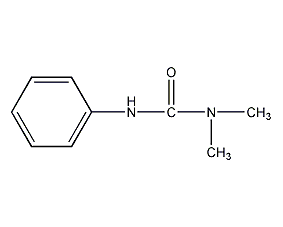
Structural formula
| Business number | 02KL |
|---|---|
| Molecular formula | C9H12N2O |
| Molecular weight | 164 |
| label |
Dybar,Fenidin,Falisilvan, herbicide |
Numbering system
CAS number:101-42-8
MDL number:MFCD00025662
EINECS number:202-941-4
RTECS number:YT1450000
BRN number:2208535
PubChem number:24868997
Physical property data
1. Properties: colorless crystalline solid.
2. Density (g/mL, 20℃): 1.13
3. Relative vapor density (g/mL, air=1): Undetermined
4. Melting point (ºC): 134-136
5. Boiling point (ºC, normal pressure): Undetermined
6. Boiling point (ºC, kpa): Undetermined
p>
7. Refractive index: Undetermined
8. Flash point (ºC): Undetermined
9. Specific rotation (º): Undetermined
10. Autoignition point or ignition temperature (ºC): Not determined
11. Vapor pressure (mmHg, ºC): Not determined
12. Saturated vapor pressure ( kPa, ºC): Undetermined
13. Heat of combustion (KJ/mol): Undetermined
14. Critical temperature (ºC): Undetermined
15. Critical pressure (KPa): Undetermined
16. Log value of oil-water (octanol/water) distribution coefficient: Undetermined
17. Explosion upper limit (%, V/ V): Undetermined
18. Lower explosion limit (%, V/V): Undetermined
19. Solubility: Slightly soluble in water, easily soluble in ethanol, acetone, Halogenated hydrocarbons, poorly soluble in alkanes.
Toxicological data
1. Acute toxicity: Rat oral LD50: 6400mg/kg; Mouse oral LD50: 4700mg/kg; Rabbit oral LD50: 4700mg/kg; Guinea pig oral LD50: 3200mg/kg; 2. Other multiple dose toxicity: Oral TDLo in rats: 13886mg/kg/61W-C; Oral TDLo in guinea pigs: 19264mg/kg/43W-I; 3. Mutagenicity: DNA inhibition Oral test: mice, 500mg/kg;
Ecological data
None yet
Molecular structure data
1. Molar refractive index: 48.87
2. Molar volume (cm3/mol): 146.2
3. Isotonic specific volume (90.2K ): 376.4
4. Surface tension (dyne/cm): 43.8
5. Dielectric constant:
6. Dipole moment (10-24cm3):
7. Polarizability:19.37
Compute chemical data
1. Reference value for hydrophobic parameter calculation (XlogP): None
2. Number of hydrogen bond donors: 1
3. Number of hydrogen bond acceptors: 1
4. Number of rotatable chemical bonds: 1
5. Number of tautomers: 2
6. Topological molecule polar surface area 32.3
7. Number of heavy atoms: 12
8. Surface charge: 0
9. Complexity: 151
10. Number of isotope atoms: 0
11. Determine the number of atomic stereocenters: 0
12. Uncertain number of atomic stereocenters: 0
13. Determine the number of chemical bond stereocenters: 0
14. Number of uncertain chemical bond stereocenters: 0
15. Number of covalent bond units: 1
Properties and stability
None yet
Storage method
None yet
Synthesis method
It is derived from the reaction between phenyl isocyanate and dimethylamine or from the reaction between aniline and dimethylcarbamoyl chloride.
Purpose
Used to control annual monocotyledonous and dicotyledonous weeds in cotton, soybean, corn and wheat fields and shrubs in non-crops. It is used for selective weeding at small doses and for killing weeding at large doses. Low toxicity, non-toxic to fish, safe to use.

 微信扫一扫打赏
微信扫一扫打赏

